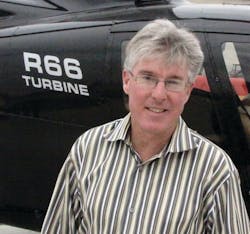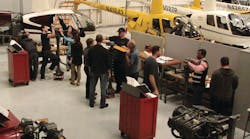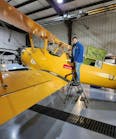AMT: What's your opinion of the overall industry right now?
KR: Overall I think the industry is pretty good, there's no question that the 2008 recession, worldwide, that was huge. That hit us like I've never seen. Typically when the United States is down we can count on Australia, China, or South America to lift us up. And that’s one of the few times in our existence when we saw the entire world go into a crunch. And that's because money was tight. People that actually had loans with banks defaulted on them. Banks said, ‘I know I told you before that I was going to give you money but I'm not going to now.’
And so we watched for a couple of years; there was this incredible tightening economically all over the world. Since then we've watched it loosen up and the markets start to get better and sales start to return in different countries. A lot of it depended on their own economies. One of the first to come out of it was clearly Australia because they were mining their ore and selling it to China which was doing good, and that was helping Australia which helped New Zealand.
Other parts of the world have started to recover but you still have Europe which isn't exactly doing great, and the U.S. is muddling as we all know. But other places are doing fairly well, and over the next four or five years I expect the (world) economy to slowly improve and for things to pick up.
Internally at our company what we did when this whole thing hit is fairly typical; basically we said if we want to get sales back we can't just rely on what we have. We were working on the R66 so we doubled down our efforts and pushed engineering extra hard because we know that nothing helps sales like a new helicopter in our industry.
So we got that certified in October 2010 and sales have been very strong. This year I expect that we will, we have already delivered 230 of them, by the end of the year be close to delivering 250 R66s in a completely new market that will help us grow. So we're very optimistic about the future.
AMT: What's your estimate of the market for piston-powered helicopters?
KR: The R22 has been a little slower to pick up, but the R44 picked up fairly quickly in late 2010, early 2011, and it’s been holding steady. It’s not nearly at the levels seen in 2006, 2007, and 2008. We were up around 600 R44s per year then. This year we will probably do 250, something like that. So it's come back but it's not roaring.
AMT: It was mentioned that there are 300 back orders for the R66 right now. Is that number fairly close?
KR: Somewhere around there. Right now we're quoting at six helicopters a week. If you place an order now (in late November 2012) you'd be looking at late June or early July in next year to take delivery.
AMT: When I last visited RHC was sending two out of three helicopters produced overseas. Is that still true?
KR: That's still true. The overseas market really depends on the countries — it's been very strong the last couple years in Australia, New Zealand, Brazil, and South America, a little bit; and South Africa has also been a very good market. Some of the other areas haven't been as strong.
AMT: Any future products or initiatives you'd be willing to share?
KR: Our big thing right now is just trying to complete certification of the R66 in the rest of the world. We've got quite a few certifications but we're still missing in Russia, Europe, and Canada. So once we get those approved we expect sales to increase. Some of the other projects we're working on is really filling out the R66 line. We're working on a float version and a cargo hook version. We're looking at the whole avionics thing; I'd say a wide spectrum view of the glass panel; things like the Aspen, the Garmin 500. We're looking at down the road being able to incorporate those into the line.
AMT: Can any Robinson Helicopters be flown IFR?
KR: No, we have a version that is set up as an IFR trainer but we don't actually have the redundancy required to fly them as a true IFR aircraft. And we don't want to go there. In the helicopter world you can fly special VFR and if it gets so bad you can't fly special VFR we'd just as soon see you put it on the ground.
AMT: At the management level, what is the RHC maintenance philosophy? For instance, field maintenance vs. factory maintenance; off-factory maintenance repair organizations (MRO), more maintenance vs. less maintenance, etc.?
KR: For one thing we want it to be predictable. If you're running a company you want it to be predictable. Nobody likes it when a customer comes in on a Tuesday and you have to tell them I can't go do that job for you because I've got a problem with the helicopter. So the reliability has been one of the things we are always working on. These two right here (Pete Riedl, vice president of engineering and Pat Cox, technical support supervisor) that's what they spend a lot of their time on — to see what issues are out in the field and make certain that we address those issues so we have reliability built in to our helicopters.
After that, we want to say at 100 hours do this, at 1,000 hours do this, at 2,200 hours do this, and just fly in between and not really spend a lot of time on maintenance.
AMT: It sounds like the RHC program is built on a cornerstone of strong 100-hour inspections.
KR: That's right.
AMT: As an OEM, what best practices and lessons you've learned can you offer to the light aircraft maintenance industry?
"Read the manual," interjects Cox. "It's right in the front of every manual; Always read instructions completely before performing a task," he went on.
AMT: Will you comment on your maintenance classes?
KR: All of our dealers and service centers are required to send the mechanic to the factory, and we don't do that just so they can add up some frequent flyer miles. We like to have them come here so they can meet the instructors like Efrain (Vargas), Pat Cox, and the tech reps, and they see everything here so when they have questions out in the field they call or they email. They can say, "Hey, this looks different to me," or "I forget how to do this," so we can help them. Once they meet Efrain or Pat they're a lot more likely to call when they forget how to do something. We really do want our dealers and people working on our aircraft to ask questions and let us know so we can help them out.
AMT: So it's a work together philosophy?
KR: Yeah, especially if they're seeing something unusual in the field so we know it. As you can see, these two are together all the time and Pat's going to Pete and saying, "Hey, I'm seeing this issue out in the field; what do you think?"
Pete often goes to Pat and asks him to call the customer, or sends out a different part to see if that works better.
AMT: The customers can now contact RHC in many different ways.
"Yeah, the email and the internet have been a Godsend," says Cox.
KR: We have machines back in our experimental department that are running 24 hours a day doing fatigue testing on components. But no matter how much we do here, and how much testing we do, until you take that helicopter and you send it to the South Pole or wherever it's going to go and let it operate in that environment, we just don't know. That to me, is what the 66 is going through now. The 22 has been out there 30 years and it's pretty rare to have someone in the field see something that we haven't seen before. Here in Southern California we can't duplicate the things they run into in the field and we can't duplicate what a mechanic is going to do.
To get back to the original question, I can't tell you how many times I've seen Pat or another tech rep hang up the phone and say something like, "I can't believe the guy tried to do it that way."
AMT: Let's ask the same question and direct the answer toward the individual maintenance technician?
"Read the manual and when in doubt ask," replies Cox. "Rule No. 1 from a maintenance perspective is like Hippocratic which is do no harm."
AMT: Does RHC see any regulatory challenges specifically related to helicopter maintenance?
"Our dealers have been really good about being able to deal with that; if the factory doesn't have approval then one of our trainers probably does. Either Efrain or Dick Sanford, he's over in England and has EASA approval. In Canada we work with the Southern Alberta Institute of Technology; it has the approval to provide the R66 training," says Pat Cox.
KR: Most countries or people that work on helicopters outside the United States have to get the equivalent of a Part 145 (repair station); we made that a requirement as far as the R66. We weren't sure how that would go over but we felt that having a true maintenance organization when you're dealing with a $800,000 helicopter made some sense to us. We wanted to cut out the people that just wanted to sell helicopters and not maintain them so we felt that by having a Part 145 (requirement) we could bring the inspector and all the requirements that are necessary.
We were stunned when everyone said, oh yeah that's what we want to do. Everybody overseas said we already have that. The surprised us. I'm surprised that here in the U.S. they don't push for a little more stringent levels.
"Did you see the warning in the flight controls part of the maintenance manual?" asks Cox. "It says, Asssembly of flight controls is critical and requires inspection by a qualified person. If a second person is not available, the installer must take a five-minute break prior to inspecting flight control connections he has assembled."
"The rules in the U.S. are completely different than anywhere else in the world. Any first or second world country, anywhere else in the world, has a mandatory second inspection. The United States does not, unless you're a repair station," he continues.
And all the fatal accidents because of non inspection have been in the United States.


